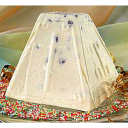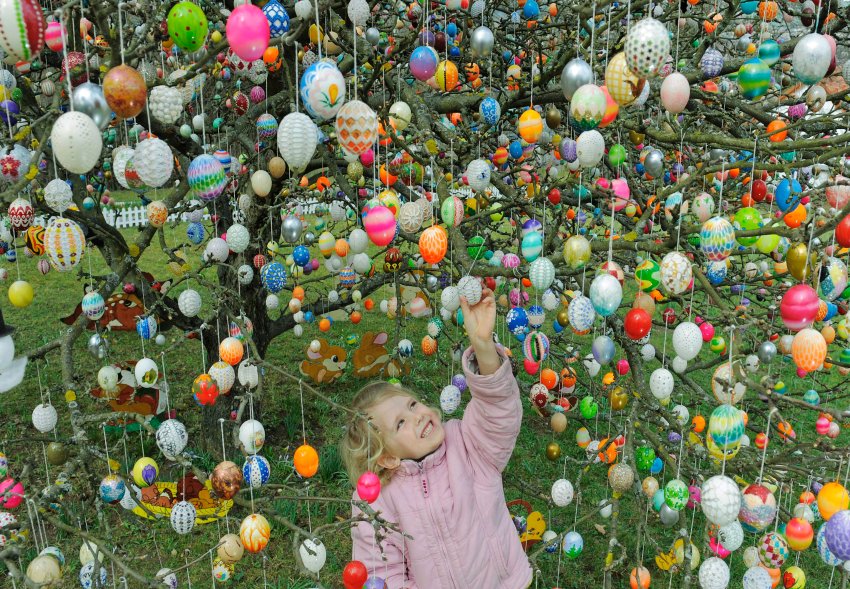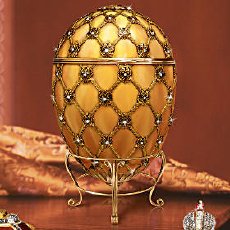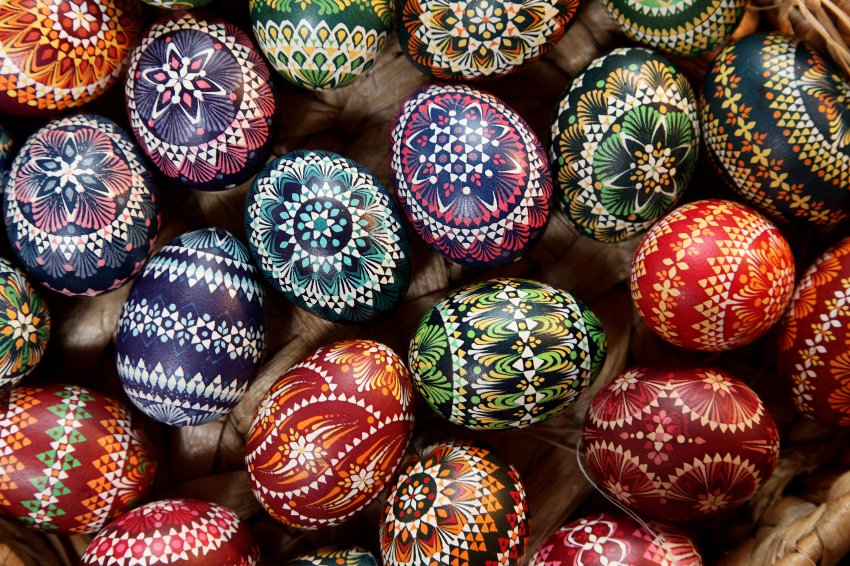Easter Feasts
Will it be chocolate Easter eggs for breakfast this Sunday?
When my children were little, we would devise an egg hunt for them on Easter Sunday morning: brightly coloured red yellow, green and blue eggs (which had been boiled in coloured dyes) plus a variety of prettily wrapped chocolate ones. Guess which ones they ate first?
Eggs symbolise new life which is why they are so prominent at Easter.In Russia and the Ukraine, people go to great lengths to decorate eggs, a tradition which reached its peak in Russia at the turn of the 19th century.
In 1884 Tsar Alexander III commissioned his court jeweller, Karl Faberge to make a special present for the Tsarina: a white enamel egg which opened to disclose a yolk in the form of a golden hen with ruby eyes. The hen bore a replica of the imperial crown, which in turn held a ruby pendant.
The Tsarina liked her gift so much that soon the royal family and the court were exchanging eggs of gold, platinum, ivory, rock crystal and coloured enamels.Quite different, and for me more beautiful, are the natural eggs decorated by Ukrainian folk artists in minute complex designs.
Such “miniature mosaics” were made in the Ukraine thousands of years before the beginning of the Christian era, and the technique of making them is still essentially the same: a design is traced in bees wax on the shell and this design is slowly elaborated in stages between repeated dippings in baths of vegetable dyes. Such fanciful eggs were the few. Most people were happy with small miracles of solid colour which they could achieve with homely materials – beetroot juice for red, birch leaves for green, laundry bluing for blue, onions skins for yellow. Decoration was scratched on the shell and took the simplest forms such as the Cyrillic letters XB which stand for Christos voskres (Christ is risen).
This ancient tradition survives in many forms.
Last year, at the Kievo-Pecherskaya Lavra cathedral in Kiev, 3000 wooden Easter eggs painted in traditional Ukrainian style were made into an artwork by Ukrainian artist Oksana Mas.
In Russia and the Ukraine, all this egg artistry goes on before Easter and once they’ve been dyed and polished with a cloth, the next step is to bake the Easter cake or kulich (see recipe). It begins with a sponge which is left to rise (prove) overnight. In the morning, more flour, together with eggs, butter, raisins, almonds, candied fruits and lemon rind plus a glass of liqueur are mixed into the risen dough and it is kneaded for 15 – 20 minutes. This mixture is then placed in a special kulich pan, which looks like a fat candle, where it is left to rise again. When doubled in bulk, it goes in the oven. A special cook’s prayer is then said to ensure the safe cooking of the kulich. Once safely out of the oven and the pan, the kulich is covered with a sugar glaze and XB is inscribed on the side. When the Easter table is set, the kulich sits in the middle surrounded by coloured eggs. Roasted meats and suckling pig, ham baked in a crust, cold turkey in a galantine, sausages and pickles are then served. Last of all is the paskha, a rich mixture of cottage cheese, cream, eggs, raisins, almonds and candied fruits which is moulded in a wooden frame in the shape of a small pyramid.
The feast continues for three days, during which time nothing is cooked or reheated.
Then each person chooses an Easter egg. The eggs are cracked together and the person whose egg remains unbroken will enjoy good luck for the rest of the year.
You can understand why such lavish celebrations evolved over the centuries in the northern hemisphere: Spring has arrived and they are farewelling the long dark days of winter.
When the Easter table is set, the kulich sits in the middle surrounded by coloured eggs. Roasted meats and suckling pig, ham baked in a crust, cold turkey in a galantine, sausages and pickles are then served. Last of all is the paskha, a rich mixture of cottage cheese, cream, eggs, raisins, almonds and candied fruits which is moulded in a wooden frame in the shape of a small pyramid.
The feast continues for three days, during which time nothing is cooked or reheated.
Then each person chooses an Easter egg. The eggs are cracked together and the person whose egg remains unbroken will enjoy good luck for the rest of the year.
You can understand why such lavish celebrations evolved over the centuries in the northern hemisphere: Spring has arrived and they are farewelling the long dark days of winter.
 When the Easter table is set, the kulich sits in the middle surrounded by coloured eggs. Roasted meats and suckling pig, ham baked in a crust, cold turkey in a galantine, sausages and pickles are then served. Last of all is the paskha, a rich mixture of cottage cheese, cream, eggs, raisins, almonds and candied fruits which is moulded in a wooden frame in the shape of a small pyramid.
The feast continues for three days, during which time nothing is cooked or reheated.
Then each person chooses an Easter egg. The eggs are cracked together and the person whose egg remains unbroken will enjoy good luck for the rest of the year.
You can understand why such lavish celebrations evolved over the centuries in the northern hemisphere: Spring has arrived and they are farewelling the long dark days of winter.
When the Easter table is set, the kulich sits in the middle surrounded by coloured eggs. Roasted meats and suckling pig, ham baked in a crust, cold turkey in a galantine, sausages and pickles are then served. Last of all is the paskha, a rich mixture of cottage cheese, cream, eggs, raisins, almonds and candied fruits which is moulded in a wooden frame in the shape of a small pyramid.
The feast continues for three days, during which time nothing is cooked or reheated.
Then each person chooses an Easter egg. The eggs are cracked together and the person whose egg remains unbroken will enjoy good luck for the rest of the year.
You can understand why such lavish celebrations evolved over the centuries in the northern hemisphere: Spring has arrived and they are farewelling the long dark days of winter.


